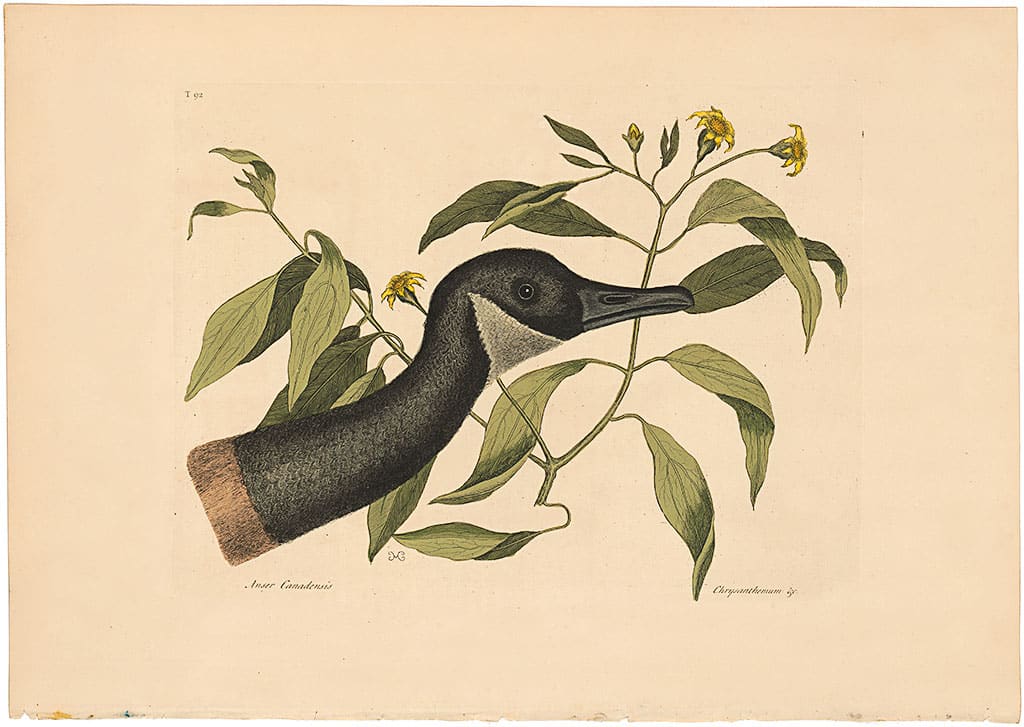Birds and Animal Art
The Most Notorious Goose in America
The Canada Goose and its Subspecies

A familiar sight in both rural and urban spaces throughout many parts of America, the Canada goose is perhaps the most pervasive and populous of its genus with more than 5 million breeding geese in North America. They can be found roaming through the manicured lawns of golf courses, gracing neighborhood parks with their refuse, and flying overhead in their characteristic V-formation. The Canada goose’s penchant for human-curated environments has caused it to be labeled a nuisance. However, Canada geese were not always as plentiful as it is today. In fact, at the beginning of the 20th century, the giant Canada goose faced extinction. It was not until the 1960s that serious efforts were made to revive and preserve the population. This essay will consider several works of art in our collection that depict the Canada goose while relaying a few facts about the species.
The Canada goose population in North America encompasses no less than six subspecies and is made up of both migratory and resident geese. The migratory geese, which constitute a smaller portion of the overall population, maintain their migratory patterns by breeding in the northern parts of North America during the milder months and vacationing in the central and southern parts of the continent during winter. By contrast, resident geese, which make up the majority of the Canada goose population, have given up long-distance migration to enjoy the protection and abundance of urban environments year-round.
In his 2013 article “Where Did All Those Canada Geese In Town Come From?”, Pat Leonard explains the inequity between resident and migratory geese populations:
Resident Canada Geese have adjusted well to living near people, with few significant curbs on their numbers. Resident geese in cities and suburbs are safe from most predators, many people like to feed them, and they are less vulnerable to hunting because they tend to live in settled areas where firearm restrictions often apply. By contrast, migratory Canada Goose populations are held in check by migration mortality, predation, late winter storms, and hunting. Resident geese begin nesting at a younger age and produce larger clutches than migratory geese. It’s no wonder their numbers are rising so fast.

Audubon’s Watercolors Pl. 277, Canada Goose
Protected by the comforts of urban life, resident geese do not face the same perils as their migratory brethren and therefore enjoy a significantly increased lifespan of up to 30 years. As a result, the overall population has skyrocketed. Interestingly, “Though resident and migratory geese may mingle during winter, they retain separate breeding ranges and do not typically interbreed” (Leonard 2013).

Canada Geese
Louis Agassiz Fuertes Original Watercolor
Louis Agassiz Fuertes’s (1874-1927) watercolor painting of the Canada Geese captures the familiar sight of a wedge of geese flying overhead as a gaggle of their companions look up in welcoming anticipation from the ground below. There are a number of reasons why geese fly in this V formation. To begin with, the configuration is energetically efficient as the updraft produced by the goose’s flapping wings works to alleviate the energy expenditure of the goose behind it. As a result, geese that fly in this formation exert half the energy of those who fly the same route alone. Additionally, Canada geese like to communicate while migrating and the V formation optimizes the goose’s ability to see and communicate with the flock.


Audubon’s Watercolors Pl. 201, Canada Goose
Likewise, John James Audubon (1785-1851) also rendered the unavoidable bird in his watercolor Pl. 201, Canada Goose for his folio The Birds of America. Here we can see a female goose nestled into a foliated enclosure while her gander protectively stands by. Interestingly, Canada geese mate for life and tend to select a partner of a similar size to themselves. Speaking of size, this particular species of goose is one of the largest and typically weighs about 12.5 pounds.
Alexander Wilson (1766-1813) also depicts the Canada goose but captures the species alongside an assortment of ducks including the Surf, Buffle-headed, Tufted, Shoveller, and Golden eye duck, which emphasizes the relational corpulence of the Canada goose. Shown mired in a watery environment, the Canada goose often retreats to the safety of lakes and ponds during molting season when for six weeks it is temporarily unable to fly.

Wilson 1st Edition, Pl. 67 Black or Surf Duck; Buffle-headed D.; Canada Goose; Tufted Duck; Golden eye; Shoveller

Catesby 1754, Vol. 1 Pl. 92, The Canada Goose
Lastly, Mark Catesby (1683-1749) highlights the distinctive long neck of the goose in his engraving. Here the goose is shown against a smattering of chrysanthemum flowers upon which it is known to nibble. In addition to tender shoots and flowers, the goose is one of the few bird species that can digest grass, which explains their partiality to well-kept lawns.
In conclusion, the synanthropic Canada goose conjures an array of responses from its human neighbors. For some, the sight of a flock of geese overhead may signal the onset of fall and crisp anticipation of the colder months. For others, there is a nostalgia to encountering the familiar bird in the parks where we played as kids. Still others perceive the bird’s pervasive and persistent presence as too conspicuous for appreciation. Whatever the response they elicit, the Canada goose remains one of the most notorious and recognizable members of the Anatidae family in North America. Moreover, the graceful figure and elegant posture of the Canada goose inspired numerous artists to make it the subject of their artwork.
[/col_inner_3] [/row_inner_3]